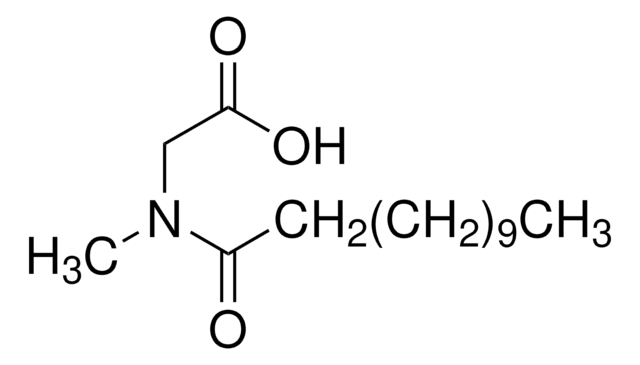61743
N-Lauroylsarcosine sodium salt
BioUltra, for molecular biology, ≥99.0% (HPLC)
Synonym(s):
N-lauroylsarcosine sodium salt, N-Dodecanoyl-N-methylglycine sodium salt, Sarkosyl NL
About This Item
Recommended Products
grade
for molecular biology
Quality Level
description
anionic
product line
BioUltra
Assay
≥99.0% (HPLC)
form
powder
mol wt
micellar avg mol wt 600
average mol wt 600
aggregation number
2
impurities
DNases, none detected
RNases, none detected
insoluble matter, passes filter test
phosphatases, none detected
proteases, none detected
loss
≤1% loss on drying, 110 °C
pH
7.0-9.0 (25 °C, 1 M in H2O)
CMC
14.6 mM (20-25°C)
solubility
H2O: 1 M at 20 °C, clear, colorless
anion traces
chloride (Cl-): ≤50 mg/kg
sulfate (SO42-): ≤50 mg/kg
cation traces
Al: ≤5 mg/kg
As: ≤0.1 mg/kg
Ba: ≤5 mg/kg
Bi: ≤5 mg/kg
Ca: ≤10 mg/kg
Cd: ≤5 mg/kg
Co: ≤5 mg/kg
Cr: ≤5 mg/kg
Cu: ≤5 mg/kg
Fe: ≤5 mg/kg
K: ≤50 mg/kg
Li: ≤5 mg/kg
Mg: ≤5 mg/kg
Mn: ≤5 mg/kg
Mo: ≤5 mg/kg
Ni: ≤5 mg/kg
Pb: ≤5 mg/kg
Sr: ≤5 mg/kg
Zn: ≤5 mg/kg
λ
1 M in H2O
UV absorption
λ: 260 nm Amax: 0.2
λ: 280 nm Amax: 0.06
SMILES string
[Na+].CCCCCCCCCCCC(=O)N(C)CC([O-])=O
application(s)
sample preservation
InChI
1S/C15H29NO3.Na/c1-3-4-5-6-7-8-9-10-11-12-14(17)16(2)13-15(18)19;/h3-13H2,1-2H3,(H,18,19);/q;+1/p-1
InChI key
KSAVQLQVUXSOCR-UHFFFAOYSA-M
Looking for similar products? Visit Product Comparison Guide
General description
Application
- of nuclease stop mix, embryo extract buffer to dissociate nonspecifically bound proteins from chromatin
- of proteinase K solution for the heat denaturation of genomic DNA
- of 10% (w/v) sarcosyl/0.5 M ethylenediaminetetraacetic acid (EDTA) solution to prepare EDTA-sarcosyl-proteinase (ESP) buffer
- in the hybridization buffer for in situ hybridization histochemistry
- in the embryo extract buffer to dissociate nonspecifically bound proteins from chromatin
- in proteinase K solution to inactivate the enzymes
Other Notes
Signal Word
Danger
Hazard Statements
Precautionary Statements
Hazard Classifications
Acute Tox. 2 Inhalation - Eye Dam. 1 - Skin Irrit. 2
Storage Class Code
6.1A - Combustible acute toxic Cat. 1 and 2 / very toxic hazardous materials
WGK
WGK 1
Flash Point(F)
512.6 °F - closed cup
Flash Point(C)
267 °C - closed cup
Personal Protective Equipment
Certificates of Analysis (COA)
Search for Certificates of Analysis (COA) by entering the products Lot/Batch Number. Lot and Batch Numbers can be found on a product’s label following the words ‘Lot’ or ‘Batch’.
Already Own This Product?
Find documentation for the products that you have recently purchased in the Document Library.
Customers Also Viewed
Our team of scientists has experience in all areas of research including Life Science, Material Science, Chemical Synthesis, Chromatography, Analytical and many others.
Contact Technical Service










